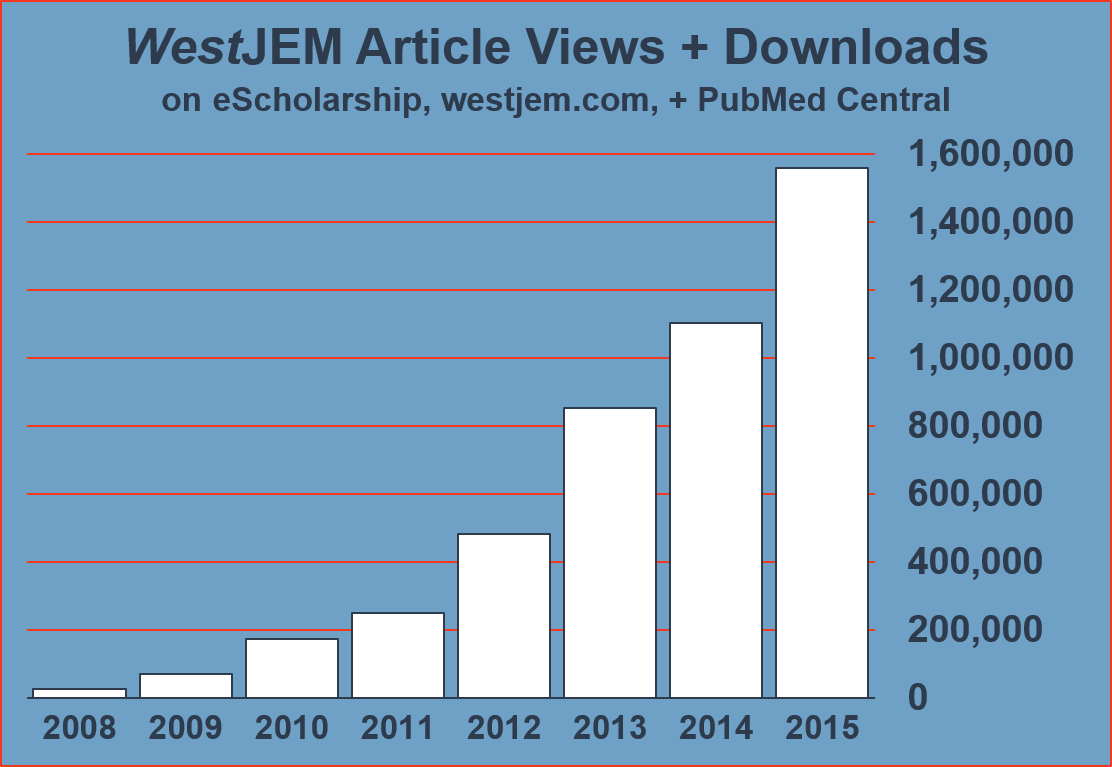 Running an independent journal is a lot of work, even if you’re just focused on managing the process of moving articles through submission, review, and publication. But publishing an article isn’t the end of the story. Even a great article won’t make an impact unless people read it. And without visibility, even a journal with a terrific editorial board won’t get the kind of submissions it’s looking for.
Running an independent journal is a lot of work, even if you’re just focused on managing the process of moving articles through submission, review, and publication. But publishing an article isn’t the end of the story. Even a great article won’t make an impact unless people read it. And without visibility, even a journal with a terrific editorial board won’t get the kind of submissions it’s looking for.
WestJEM – the Western Journal of Emergency Medicine: Integrating Emergency Care with Population Health – gets ten times the submissions that it got a decade ago. In 2008 it averaged about 2,000 combined article views and downloads per month; by 2015 that number had climbed to 130,000. Without the support of a large publisher, and charging a modest $400 article processing fee, the journal’s resources are limited. So what’s the secret to its success? Well, it doesn’t hurt to fill a need in an active and growing field – or to have a hard-working board of editors thinking about savvy strategies to build connections with professional organizations and academic departments. But one crucial piece that cannot be overlooked, according to Mark Langdorf, Editor-in-Chief and UC Irvine Professor of Clinical Emergency Medicine, is getting indexed – and finding the right resources to help make that happen.
Indexes – and databases, directories, and their kin – are compilations of descriptive information about journals and the articles they contain. Some are discipline-specific; others cover a broad range of topics. If a journal is well indexed, readers are more likely to discover its content, regardless of whether or not the journal itself is known to them. But getting indexed can be difficult. While most indexes make their inclusion criteria publicly available, those criteria may be hard to meet. Indexes compete for users – and usually paid subscribers – the same way journals compete for readers. They may advertise that they include more journals than their competitors, but they also want to say they have the best quality journals, so it’s in their interest to vet publications carefully. And even if a journal seems eligible for inclusion, it can be labor intensive to bring the journal to the index’s attention and make the case that it should be added. For MEDLINE, a database run by the National Library of Medicine, the demanding process of being reviewed and accepted took WestJEM four persistent years.
Unsurprisingly, working with indexes can be a challenge for the average journal editorial board team. Fortunately for WestJEM, its board includes one unusually well-equipped member: UC Irvine Health Sciences Librarian Linda Murphy. Librarians spend a lot of time working with indexes. They may need to compare their features and coverage, decide which ones to recommend to their students and researchers, or figure out which ones are the most responsible way to spend the library’s increasingly tight budget. Because of this multifaceted customer/recommender/user role, they’re more likely to be able to get the attention of indexes and speak their language. Murphy, says Langdorf, has played an essential role in WestJEM’s indexing success.
For her part, Murphy says she’s learned a lot, both from her fellow board members and from the indexing process. She offers these tips for journals that are thinking about beginning an indexing project:
- Start by identifying which indexes to target, and which ones to prioritize within that list. Working with a librarian can help.
- Review the indexes’ requirements. Each has a publicly available description of what they’re looking for with a link to their online journal suggestion form. Some forms demand more details than others or allow more space for you to justify inclusion.
- Be persistent; don’t give up after a first rejection. The acceptance process takes time.
- Indexes vary, and base their decisions on a wide variety of criteria. Some just focus on article quality and require journals to submit issues for review. Some also want to see international representation on an editorial board. Medical journals may have particular requirements around conflict of interest disclosure.
- Having a dialogue with the reviewers is crucial. It can expose questions that may be easily resolved, or clarify concerns about reasons for rejection or delay.
- Sometimes a journal might have to adjust the way it operates if its goal is to be accepted to a major database. For instance, WestJEM was told by both MEDLINE and Web of Science reviewers that the journal didn’t have enough non-U.S. authors and editors. In order to address this requirement while maintaining writing quality for authors whose first language isn’t English, WestJEM has partnered with international emergency medicine organizations to improve the quality of international submissions. MEDLINE also found the journal title too broad, so WestJEM added a subtitle that clarifies its niche to “Integrating Emergency Medicine with Population Health.”
- Journals may get frustrating rejections that they can’t do anything about, such as an index claiming it already has “too much” in a given subject area. This is an issue WestJEM continues to discuss with Thomson Reuters regarding their Science Citation Index.
- Worried about indexes putting a premium on exclusivity, and that being open access will hurt your chances? Don’t be. Many indexes consider open access journals to be desirable additions, and open access to the journal’s content makes it easier to review it for quality.
WestJEM’s inclusion in MEDLINE (covering issues from 2014 onward) follows its indexing in Scopus (2011), CINAHL (2010), and PubMed (2007), among others. Langdorf and Murphy say the long hours invested have been worth it. What started as a 4 page newsletter in 1999, then became a regional journal, is now a publishing force to be reckoned with. The quantity and quality of submissions continues to climb alongside their views and downloads (on their independent site westjem.com, in eScholarship, and especially on PubMed Central). So do citations to WestJEM articles. Having gotten a handle on indexing, they’ve moved on to explore new opportunities like interactive issues and Altmetrics.
 One thing has remained constant during these long years of growth: the journal remains focused on serving the emergency medicine community. Part of that focus is a commitment to the open access model that ensures that everyone working in this field – a specialty that deals with social injustice, health and economic disparities, violence, substance abuse, and disaster preparedness and response – can read the articles. WestJEM publicly shares – and tries to minimize – its acceptance-to-publication time while maintaining its rigorous peer review process and ethical standards so it can spread new knowledge quickly. The journal also waives its article processing fee – already low compared to other journals in the field – for authors from low-income countries and for faculty of departments that participate in their membership/print subscription program.
One thing has remained constant during these long years of growth: the journal remains focused on serving the emergency medicine community. Part of that focus is a commitment to the open access model that ensures that everyone working in this field – a specialty that deals with social injustice, health and economic disparities, violence, substance abuse, and disaster preparedness and response – can read the articles. WestJEM publicly shares – and tries to minimize – its acceptance-to-publication time while maintaining its rigorous peer review process and ethical standards so it can spread new knowledge quickly. The journal also waives its article processing fee – already low compared to other journals in the field – for authors from low-income countries and for faculty of departments that participate in their membership/print subscription program.
Many independent journals out there share a similar dedication and willingness to adapt, despite all kinds of challenges: staff turnover, financial constraints, technology challenges. But the trickiest and most daunting hurdle can be building the community of authors, reviewers, and readers necessary to keep a publication going strong. There are a lot of pieces to the puzzle, but it seems clear that indexing – and working with a local librarian – is a wise one to invest in.
Tags: eScholarship, Open Access, UC Irvine



